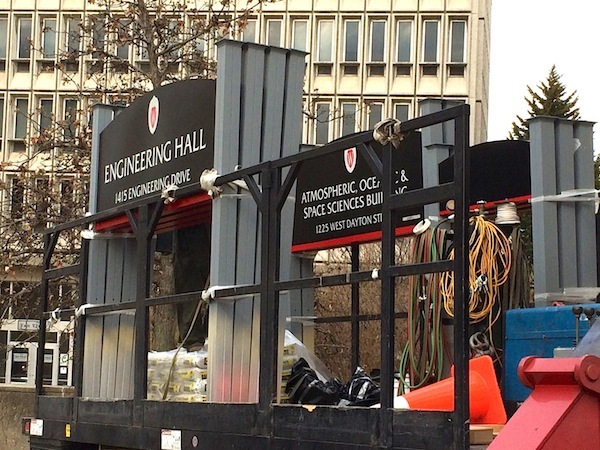Campus signs get a makeover

The new signs, shown on a truck as crews deliver them to installation sites, will help give the campus a unified look.
Campus buildings are being marked with new signs that have a single, unified design as part of a project undertaken by UW–Madison’s Division of Facilities Planning and Management.
The process began about 10 years ago when university buildings featured several different versions of signs in a variety of styles and ages. Now, nearly all buildings can be identified through a black, arched design that includes the university crest.
The project aims to unify the identity of campus buildings and help improve wayfinding for campus users, says Gary Brown, director of campus planning and landscape architecture.
One of the signs at South Hall on Bascom Hill.
“It makes people be more aware of what is or isn’t a university building,” Brown says. “It makes it a lot easier for people to find buildings if they know they’re looking for a particular type of sign with specific information on it.”
The overhaul had initially taken place on a piecemeal basis. Whenever a new building project was completed or an academic department made a request, the sign was updated.
While the signage project has taken nearly a decade, there have been upwards of 500 signs that needed to be replaced. Besides academic building identification signs, Eagle Heights housing and campus residence halls have received the new sign style as well.
Wayfinding signs and a main university sign located on North Park Street are also included in the project.
While the signage was the primary aspect of this design overhaul, it has not been the only one. Other site elements such as benches, light poles and trash receptacles are black to match the color scheme of the signs, Brown says.
Additionally, Brown says the arches on the signs were selected to match the curved back on the benches. Small, subtle arches were also added atop most campus light poles and the top of the new campus bus shelters.
“The idea was to try to pick a theme and use that throughout all of the site elements we have across campus,” Brown says. “The graceful arches also symbolize the glacial drumlins of Bascom Hill and Observatory Hill on which the campus is built.”
The entire project’s completion is expected by the fall semester. As the overall university master plan continues to drive change across campus, the new signage will be kept updated as academic departments move and if and when buildings get renamed.
– By Jim Dayton




